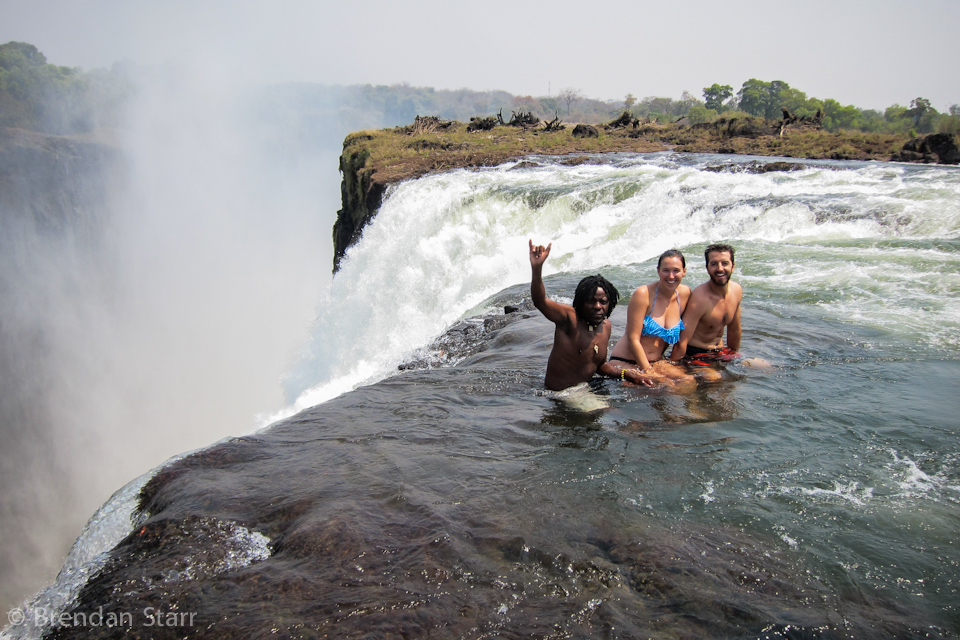Swimming in Victoria Falls
"When you jump, make sure you jump out, toward the falls. Let the current pull you to the edge, and then catch yourself on the shelf before you go over." Brendan went first. He jumped off the rocks, floated several feet down river and sat up on the four-foot ledge that stands between the top of the Zambezi and Victoria Falls. Just behind him, water fell down the 350 foot drop sending white clouds of mist back up the length of the Falls and creating a perfect double rainbow (what does it mean?!). I followed and in a matter of minutes we were both sitting of the edge of a waterfall.
To be completely honest, the experience saved the visit to Victoria Falls Park. During dry season, the Falls don't exactly form the thundering curtain of water you've seen in photos and guidebooks. It's still very pretty and it's nice to miss the crowds, but we found ourselves walking the trails wondering if "that" was Victoria Falls. We were worried that we'd leave disappointed, but getting to swim to the edge of the Falls completely made up for it. It was a different pay off than we'd expected, but in many ways it was even more memorable. Moral of the story... If you can't see Vic Falls at its most impressive (Nov. - April.), make sure you can get in the water! Note that you can only do this on the Zambia side (Vic Falls straddles Zambia and Zimbabwe) during dry season so plan accordingly!
Two days before our swim, we had reluctantly left South Luangwa, driving through the park one last time on our way out behind a pair of giraffes on a morning stroll. We flew from Mfuwe to Lusaka, found our way back to Lusaka Backpackers and hopped a bus to Livingstone the next morning after a quick breakfast and a chance meeting with a fellow American (more on that in a later post). We wanted to check out (and off) Victoria Falls before we left Zambia. We arrived in Livingstone completely un-researched. We only wanted to see Victoria Falls and figured we could easily wing it. We were right... Livingstone is small and the Falls are by far the biggest attraction.
We found a taxi at the town center, got a ride out to Victoria Falls National Park and inquired about the "Devil's Pool Experience" which we had seen advertised at our lodge the night before. Within an hour (and after signing some papers promising we wouldn't try to fly off the waterfall and preventing us from suing anyone if we did), we headed out along the dry edge of the Falls. The walk takes about an hour and offers some nice views of the Falls along the way.
Like many activities in Africa, there are few (if any) rules, so we were limited only by our own comfort zone and common sense - if we had wanted to try hand stands on the edge, our guide probably would have wished us luck. We opted out. After the walk, we were told to disrobe and swim across a section of the Zambezi over to a small rock "island." The river signifies the heart of Victoria Falls, and there is a current to prove it. There is a small net between the swimmers and the edge, but it was some comfort to know that Brendan and I are both decent swimmers. Our guide kept the boogie board to himself. Once we were all safely on the rocks and issued our basic instructions, we jumped in. For the next 20 minutes, we swam, "flew" over the edge, posed for photos and waved at those less fortunate tourists in Zimbabwe.
Before we left the park, we walked down to the lower part of the river, to an area called the Boiling Pot and watched a bungee jumper have her own adventure. We also haggled at the market for a "handmade" ebony elephant and finally got a great price of 35,000 Kwacha (about $6). We've seen the exact same elephant in every market since, so I'm pretty sure we were duped, but we got to practice our good cop (Brittni) / bad cop (Brendan) negotiating tactics, so all-in-all, it was a successful shopping trip.
Dinner at the Zambezi Cafe that night turned out to be a pleasant surprise... By far the
best fish we've had in Africa! We went to bed satisfied with our Vic Falls excursion and woke up ready for Cape Town.



















